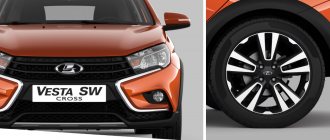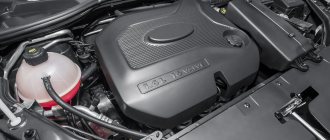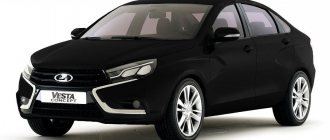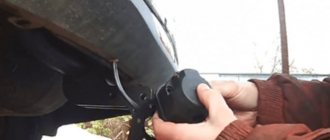The better quality Russian roads become, the lower the ground clearance of the cars that our colleagues in the diverse Russian auto garage community purchase. For example, in megacities the percentage of low-clearance vehicles prevails in comparison with elevated vehicles, while in the Russian outback, which is absolutely expected, everything is exactly the opposite.
However, recently, automotive trends not only in Russia (and an example of this is the Vesta SV Cross), but throughout the world have changed somewhat towards the production of crossovers, namely, all the corporations that set the automotive fashion are beginning to develop and produce both station wagons and sedans with off-road capabilities.
As for the Vesta SV Cross station wagon with a ground clearance of 203 mm, its production together with the Vesta station wagon and Vesta sedan, and then with the Vesta sedan cross version, was launched at the production facilities of Lada Izhevsk.
Thus, it turns out that AvtoVAZ is offering our brother two cross-country or with raised bodies of the Lada Vesta SV, namely the Vesta SV Cross in the guise of a station wagon and the same model with increased ground clearance, but in a sedan body.
For the newly-minted representatives of our garage community, we explain that the universal body is fundamentally different from the sedan body by the presence of:
- extended roof and rear marker lights;
- combined space of the cabin and luggage compartment;
- as well as the presence of a luggage or fifth door.
Technical characteristics of LADA Vesta - body, engine, transmission
The technical characteristics of the LADA Vesta are comparable to similar cars of this class, and here Russian manufacturers decided not to stand out - after all, we are talking about a budget model, so if there are additional modifications, they will be included in the category of a limited series “limited edition”.
Characteristics of the body and transmission of LADA Vesta
The body of the LADA Vesta is much more spacious than its classmates, because its dimensions are located outside the standard B class size classification. It is for this reason that Lada Vesta is classified as subclass B+.
| Name | Class | Length | Width |
| Extra small | A | up to 3.6m | up to 1.6m |
| Small | B | 3.6 – 4.2m | 1.5 – 1.7m |
| Small medium | C | 4.2 – 4.4m | 1.6 – 1.75m |
At the same time, the car is perfectly adapted for the Russian consumer - it has an increased ground clearance of up to 171 mm when fully loaded and a small turning radius of only 5.2 m. Good controllability and responsiveness of the steering wheel are ensured by new characteristics and the layout of the car's transmission - independent front suspension with classic McPherson struts and semi-independent rear suspension on an elastic transverse beam with spaced springs and shock absorbers. As a new feature, the Lada Vesta uses a lower steering rack, which will further increase the information content of the steering wheel. Disc brakes at the front and drum brakes at the rear will be equipped with modern ABS and ESP systems.
Characteristics of the LADA Vesta engine
The Lada Vesta engine line includes three modifications of 1.6-liter power units: 11189 (8-valve, 87 hp), 21129 (16-valve, 106 hp) and HR16 (16-valve ., 114 hp). Moreover, the latest option was developed jointly by members of the Renault-Nissan alliance. It is assumed that an automatic transmission will only be available on the 106 hp engine, although in the future it is possible to expand the available variations. All engines comply with EURO 5 environmental standards and will be actively used in export deliveries of LADA Vesta abroad. Preliminary tests pegged the car's top speed at 185 km/h, with a 0-100 km/h time of just 10.3 seconds, which is pretty good for consumption of 6.9 l/100 km.
In general, the technical characteristics of the Lada Vesta meet the requirements for the car and are designed to provide driving pleasure to an unpretentious driver. I will warn critics against making malicious remarks, the LADA Vesta is a budget car, and you don’t need to demand Ferrari characteristics from it.
| Characteristic | Sedan | Hatchback |
| Curb weight, kg | 1190 | 1150 |
| Length, mm | 4410 | 4250 |
| Width, mm | 1764 | |
| Height, mm | 1497 | |
| Wheelbase, mm | 2635 | |
| Front/rear axle track, mm | 1510 | |
| Turning radius, m | 5,2 | |
| Ground clearance (at full load), mm | 171 mm | |
| Aerodynamic factor, m2 | 0,82 | 0,85 |
| Engines 1.6 l | 11189 (8-valve, 87 hp) 21129 (16-valve, 106 hp) HR16 (16-valve, 114 hp) | |
| Fuel consumption in combined cycle, l | 6,9 | |
| Maximum speed, km/h | 185 | |
| Acceleration time to 100 km/h, sec | 10,3 |
What is the real ground clearance of the Lada Vesta
Ground clearance of Volkswagen Passat CC Volkswagen Passat CC 1.8 AT 160 hp.
Cars with a small height from the supporting plane to the bottom of the body are not recommended for Russian roads, since the road surface is generally not of the best quality. In this regard, domestic cars have never stood out for being too low in height. This also applies to the Lada Vesta, which is a rather tall car.
Therefore, when purchasing this car for driving on Russian roads, you need to pay attention to important technical characteristics such as Lada Vesta ground clearance or ground clearance
Ground clearance is the height from the plane on which the machine stands to its lowest point in the central part relative to this support. In other words, this is the ground clearance between the asphalt and the bottom plane of the car. To increase the vehicle's maneuverability in hard-to-reach places, it is necessary to increase its ground clearance. But this applies only to bad roads, since on high-quality surfaces with high speeds it needs to be reduced. This is due to the fact that the higher the car’s ground clearance, the higher its center of mass is located, which directly affects the handling and stability of the vehicle.
When planted, this vehicle feels better on the highway at high speeds than when raised. In most cases, the distance between the plane of the support and the bottom point of the car is indicated in millimeters
Sometimes the amount of ground clearance under the rear and front axle is important, since for rear-wheel drive cars these indicators may differ, while for front-wheel drive cars they are approximately the same
A good height between the car and the road makes it easier for the car to overcome sections of the road where there is no quality coating or it is badly damaged.
What is the ground clearance of the Lada Vesta
The technical characteristics of this model with a sedan body type are quite high in comparison with those of its main competitors.
According to official information, the following clearance values are determined:
- when fully loaded under the engine crankcase - 171 mm;
- under the engine splash guard (at full load) – 144 mm;
- without loading under engine protection – 190 mm;
- under the bumper overhang (without loading) – 230 mm.
To understand what the above numbers mean, you need to understand what the full load is for the Lada Vesta. This is the sum of the mass of the car with all components, transported luggage, as well as the mass of the driver and passengers. This value is the maximum permissible for the vehicle. The difference between the full load and curb weight for the Lada is 400 kilograms.
Since the car is most often not used at full weight, the ground clearance between it and the road will be higher. The ground clearance of this model may differ slightly from what is indicated in the technical documentation due to the use of tires and rubber on wheels of different diameters.
An official AvtoVAZ source says that tires of size 185/65R15 (16) should be used. This fact should not be neglected, since the correct wheel parameters directly affect how the car will behave on the road.
A not very lowered model with a hatchback body type, the production of which is expected in the near future, will differ from the sedan body type in that its ground clearance may be slightly lower. The difference should not be big, since car sales are designed primarily for motorists in the Russian Federation.
AvtoVAZ presented a new serial version of the Lada Vesta with a station wagon body type, as well as in a cross-modification, which assumes the presence of increased ground clearance. The implementation of new products is planned in the second half of the year.
Main overall dimensions and appearance
Both models are made in the same stylish design with a pronounced letter X on many parts of the cars.
The head optics and the front part of the body with the radiator grille are practically the same. The same X-shaped stampings on the fenders and doors of the cars attract the attention of others. The interior and ergonomics of the cabin have minor differences
Comparison of Lada Vesta with Lada X Ray Both of these models cannot be compared on the same scale
First of all, they are made in different body types, which means that a comparative analysis must be carried out taking into account this important design difference
| Options | Lada X-Ray | Lada Vesta |
| Length/width/height (mm) | 4165/ 1764/ 1570 | 4410/ 1764/ 1497 |
| Wheelbase (mm) | 2592 | 2635 |
| Body/number of doors | Crossover/5 | Sedan/4 |
| Ground clearance (clearance) (mm) | 195 | 178 |
| Luggage compartment volume (l) | 361 | 480 |
| Curb/maximum weight (kg) | 1190/1650 | 1230/1670 |
| Fuel tank volume (l) | 50 | 55 |
The X Ray crossover, thanks to its significant ground clearance and short wheelbase, has advantages on roads with worse surfaces and on poor off-road conditions. In terms of dynamic characteristics, it loses to the more stocky and streamlined Lada Vesta sedan, whose center of gravity is lower and stability on the highway is much better than its competitor. If you compare the Lada Vesta in city traffic on the asphalt, in terms of maneuverability it is not much different from the X Ray.
Lada Vesta ground clearance
Lada X Ray Cross
Lada Vesta is a Russian car that began production in September 2015. Its sales started two months after the start of production. AvtoVAZ carefully hid the technical characteristics of the car until the last moment. The manufacturer presented a raised sedan called Lada Vesta on September 24, 2015 with a video presentation of a test drive on the roads of Italy. Only after the presentation it became clear that a fairly significant player from a domestic manufacturer had appeared on the market, which in terms of price and quality could compete with many foreign car brands.
How much clearance does the Lada Vesta have?
What kind of oil to pour into the Lada Vesta engine
Vehicle characteristics: The dimensions of the car are as follows: length - 3247, width - 1100, height - 1203 mm. The wheelbase is 2264 mm. Ground clearance 137 mm. The car is equipped with a hybrid power unit. The 4-cylinder engine is equipped with a system that provides engine power output. There are 4 valves per cylinder. The diameter of one cylinder is 76 mm, the piston stroke is 70 mm. The engine crankshaft accelerates to 7000 rpm. Maximum torque is maintained up to 4000 rpm.
Category: Repair instructions
Posted by admin: at the request of Hamlet
Views: 2264
Watch the VIDEO about the clearance of the Lada Vesta.
Criticism of a car owner named Josaphat: + Handling. + Equipment (Comfort). Heated seats, airbags, heated windows, power windows, etc., etc. + Interior (and the appearance of plastic, and space, and the design of the dashboard, and upholstery fabric, and all sorts of goodies such as two sockets with cup holders, etc.) + Ergonomics front seats + Standard sound (though, in comparison with Renault and VAZ) + Appearance + I can’t say anything objectively about sound insulation. Well, not really. But what to compare with? I compare it with Matis, with the eight .. —) So, for me it’s excellent.+ The steering wheel is 10 out of 10. Many people don’t like it. I want something more extreme. For me, such a plus is the obedient, gentle steering wheel. + Possibility of selecting modes: eco, sport. In sports - a beast! I don’t use it, it’s still early) + The machine is good. Maybe he hangs up a little, thinks, but only in IVF mode. I respect thinkers + Trunk. Not small. And it opens without harming a lady’s manicure (this is a woman’s review! :-))+ The glass washer tank is gigantic! Just right for our roads. In general, there is beauty under the hood, of course!+ The suspension is just what the doctor ordered (for me). Not hard, not soft, but just like that)
Original title: Apa lumen Lada Vesta
Release date: 05/22/2015
Duration: 4:26
Quality: HD
Laughter in the topic: You chase two hares, YOU Catch BOTH, EVERYONE APPLAUSES IN DECISION, THE LION WALKS UP AND SHAKES HAND, THE HARRIES WATCH WITH RESPECT, TAKE PHOTOGRAPHS
Suspension
The chassis of the Lada Vesta is an advantage of this car.
The rear is completely taken from the Renault Megane, but the engineers did a very good job with the front, creating it from scratch using L-shaped arms, mounting on a subframe and MacPherson struts. Some components, of course, were taken from Alliance cars, but in general it was the front suspension that turned out to be a unique and successful development by our engineers. Precise tuning and successful suspension design made Vesta a comfortable and obedient car. Even in the very first tests, experts noted the car’s obedience, its directional stability in corners and other advantages.
Lada Vesta Cross - ground clearance
Industrial progress has reached Russian production; AvtoVAZ never ceases to amaze with the uniqueness of the cars it produces, year after year creating more modern and more reliable cars. The new Lada Vesta Cross station wagon is one of the most interesting and original models of the domestic automobile industry. Even before it left the assembly line, AVTOVAZ’s flagship model SW Cross attracted attention with its appearance and design features and technical characteristics. In 2022, the assembly of the long-awaited Russian station wagon began and immediately aroused even greater interest and resonance.
What is the ground clearance of the Lada Vesta St. Cross?
The clearance of Vesta Cross is truly outstanding, it is 203 mm.
Other car sizes:
The ground clearance allows it to compete with almost all modern crossovers of various brands and modifications.
Ground clearance comparison with competitors
The main competitors of Vesta SW Cross are objectively considered to be Lada Largus, KIA Rio X-Line, as well as the initial versions of Renault DUSTER and Hyundai Creta with front-wheel drive. However, the Lada Vesta Cross is not the last among them in terms of ground clearance. So for Largus the ground clearance is 145 mm, for Rio X-Line it is 170 mm, for Renault DUSTER it is 210 mm, and for Hyundai Creta this value is 190 mm. Thus, we can conclude that only the Renault DUSTER SUV can compete in terms of ground clearance, but we should not forget that the design features of the Lada Vesta Cross and the foresight of domestic developers did not easily make it possible to yield to a competitor in this area.
What is the Vesta Cross capable of off-road?
The Lada Vesta Cross feels confident both on a flat road and on a country road or even off-road. If you like to have an active holiday while driving a car on minor off-road conditions, the AVTOVAZ flagship is ideal for you. “SW Cross” is equipped with such off-road attributes as a protective plastic body kit and increased ground clearance. A protective black plastic body kit reliably protects the paintwork from chips and scratches, and the increased clearance allows you to confidently overcome obstacles on rough terrain.
Let's add to this attributes a powerful and economical engine, an energy-intensive suspension, and from ordinary driving on rough terrain, your trip turns into easy, pleasant and comfortable. The Lada Vesta Cross is also equipped with such options as cruise control and directional stability system, which will help the driver cover tens of thousands of kilometers without feeling tired or inconvenient.
Is it possible to increase the ground clearance of Vesta SW Cross?
Returning to the mention of the only competitor of the Vesta Cross station wagon in terms of ground clearance - Renault Duster, whose ground clearance turned out to be the highest, I would like to note that for drivers for whom the clearance of the Vesta SW Cross station wagon is not practical enough, they have a real opportunity to raise it height. In order to do this, it is necessary to make a number of modifications.
Increasing the ground clearance at the rear can be achieved by installing metal spacers under the strut support. To carry out such manipulations, you do not need to be a specialist in the field of mechanical engineering; any driver will be able to do this task and will take only 15-20 minutes. As a result of this modification, the rear clearance of the Lada Vesta Cross can be increased by 2-3 centimeters. You can do the same with the front part; this procedure will require the same algorithm of actions from you; the ride height will increase after installing the front strut support spacer.
Design
Lada Largus ground clearance (clearance)
The second noticeable plus is the appearance of the car. Even the ordinary Lada Vesta still arouses interest in many regions. What can we say about a car with increased ground clearance, on 17-inch wheels, with a plastic body kit on the bottom of a bright red body (optional color “Mars”)! No tuning needed. The interior of the Cross is also more elegant than in the regular Vesta, with numerous orange inserts.
What should a car be like for real Russian roads? A car created by a domestic manufacturer, fully adapted to Russian conditions and as comfortable as a foreign car, passable and with sufficient ground clearance. "Lada Vesta" meets all these needs.
For a long time, AvtoVAZ’s ambitious plans to create such a car were considered fiction, and not without reason, because there are many unrealized ideas. The developments did not go into series for various reasons, but this car has long gone beyond the scope of the project.
Pleasant exterior design, comfortable ergonomic interior, modern equipment - all this is inherent in Vesta and perfectly demonstrates AvtoVAZ’s further approach to creating cars.
Jokes aside
For more than 20 years, the domestic auto industry has not been able to please with either the quality, technological equipment, or practicality of its products. The question of the survival of the Russian giant was pressing, and bold decisions had to be made.
The complete rejection of obsolete body models, the use of modern technologies, the close integration of Russian equipment with that of partners - all this made it possible to create an interesting concept. And he delighted many Russians. It was unexpected and pleasant. The concept was modern and beautiful. It was clear that the car had good ground clearance, suitable for Russian realities.
The Lada Vesta, whose performance was supposed to be better than any competitors in its segment, gave many people hope for a comfortable ride.
The successful suspension structure largely repeated the French SUV, but was a little softer. The car overcame potholes, bumps and impressive mounds completely calmly. Off-road capability was up to par, even though it was a sedan.
Of course, the high ground clearance largely contributed to this. Even in the most severe stress tests, Lada Vesta performed exceptionally well.
Nobody will make a better car for Russian roads than a domestic manufacturer. The designers knew very well what the new car would have to face and took all the necessary measures. The new suspension was borrowed from Renault Duster and has long proven itself to be reliable.
However, Vesta is a sedan, so the suspension was qualitatively improved in the direction of softness. One of the most important design decisions was the increased ground clearance. Lada Vesta has a ground clearance of 178 mm. This is more than enough for use in urban conditions and off-road.
The car was conceived as a new people's car, which will be relevant both in the village and in the city.
Initially, high ground clearance was not enough for rural areas, and therefore Vesta Cross was created. This is not a sports version, as many people think. First of all, this is a good off-road station wagon.
Technically, this model is no different from the regular Vesta. With the exception of plastic body kits and increased ground clearance. The Lada Vesta Cross has a ground clearance of 198 mm, and this is enough for almost any obstacle.
Ground clearance for a regular Vesta
What is the ground clearance of the Lada Vesta? Keeping in mind the quality of domestic roads, AvtoVAZ engineers, when designing the Vesta model, which became a revolutionary breakthrough for Togliatti designers, planned its ground clearance of 171 mm when loaded. But, these parameters were stated based on 16-inch wheels, but in fact, the installation of 15-inch wheels is now practiced, so Vesta’s ground clearance turned out to be slightly less than originally stated.
Of course, high ground clearance has its advantages, especially for residents of the outback who also want to drive modern sedans. But, high ground clearance also has disadvantages that appear during dynamic driving. For example, handling, chassis energy consumption, and ride comfort noticeably deteriorate.
But, the designers of the Lada Vesta managed to find a “golden mean”, bordering between controllability, comfort and maximum ground clearance. The model handles quite well, and at the same time, it can overcome noticeable road irregularities without causing much discomfort to passengers. Increasing the ground clearance of the Lada Vesta is possible with the help of additional spacers, but then the driving characteristics of the car will change greatly.
So the engineers did their best and achieved significant results, which is confirmed by a comparative analysis with famous foreign cars. If we take a car with similar characteristics, then we can note that the Lada Vesta, in terms of ground clearance, is higher than the Nissan Almera, and has almost caught up with the Datsun on-Do sedan, with its 174 mm, which is the leader in this indicator in this class of cars.
Transmissions
The buyer is offered two transmission options to choose from: a manual gearbox from Renault and an AMT robotic gearbox from AVTOVAZ.
The option with a “mechanics” from Renault was chosen in order to deprive the domestic car of one of the most significant shortcomings - noise in the gearbox. There was simply no time to develop and launch production of its analogue, so the choice fell on JH - this transmission has proven itself well in many cars.
Instead of a full-fledged automatic transmission, the car is equipped with a robotic transmission, which is AVTOVAZ’s own development. In fact, this is an old VAZ 2180 transmission, which was equipped with electric drives. The gearbox was created and refined together with the ZF company, and parts for it are manufactured using more precise equipment. This option has certain disadvantages: the noise in some gears has become quieter, but remains the same, the electronics do not always select gears quickly, the first gearboxes often broke and had to be replaced under warranty. The use of this option is justified from an economic point of view, since it costs noticeably less than a full-fledged automatic machine, and maintenance and repairs in the event of a breakdown will be noticeably cheaper.
The Lada Vesta Cross sedan will receive off-road ground clearance
If we know almost everything about the Lada Vesta Sport sports sedan thanks to numerous leaks in the databases of Rosstandart, Rospatent and supplier catalogs, then the future of the cross-version of the sedan has still remained vague.
Raised sedans are generally rare on the market; in fact, there is only the large Volvo S90 Cross Country, which plays in a completely different league than VAZ products. Therefore, the appearance of a production version of the Lada Vesta Cross sedan was in question.
But, judging by the Vehicle Type Approval (VTA) that appeared in the Rosstandart database, the plant nevertheless decided to introduce such an unusual modification. The dimensions of the car coincide with the dimensions of the Lada Vesta SW Cross station wagon, with the exception of the height (1526 versus 1537 mm), which is due to the fact that the cross station wagon was initially certified with luggage rails on the roof. Thus, it turns out that the ground clearance of the Lada Vesta Cross sedan will exceed 200 mm: a completely off-road indicator!
AVTOVAZ has certified the cross-sedan with both engines that it offers for other versions of Vesta: a 1.6-liter with 106 hp. and 1.8-liter, 122 hp.
For the first time, Lada Vesta project manager Maxim Sarzhin announced that the car would become a production car in October last year. Thus, we can assume with a fair amount of confidence that the car will hit the market in the near future. Most likely, it will be produced in rather limited editions and only in an expensive configuration with heated second row of seats, two-tone interior design, 17-inch alloy wheels, etc.
- In July of this year, AVTOVAZ will begin production of the Lada XRAY Cross, which was shown as a concept in 2016.
- Another new product should be the updated Lada Granta. The plant has already launched prototypes for road testing.
Peculiarities
Resetting trip computer readings
It is difficult to reset these readings on your own if you do not know the algorithm and do everything on a whim. First you need to hold down the top key, which is located at the end of the steering column switch (right). Then go to the computer submenu. Using the same button, you need to find the time value in the menu and hold the key again. After this, you need to exit the submenu by pressing the lower key at the end of the switch.
As you can see, the algorithm is definitely complicated.
Reset
This is another feature of the on-board computer of the Lada Vesta SV Cross station wagon. While cruise control is on, the reset function is not available.
Side mirrors
The car does not have an electric drive for folding the side mirrors, so you have to do it manually. On the other hand, if you do not fold the mirror completely, it returns to its original position on its own. This is a very useful feature, especially if you accidentally hit the mirror of another car.
Bluetooth
When a mobile phone is connected via Bluetooth, the electronics limit the conversation volume. In this case, the maximum value is 10 units, and this is only 1/3 of the maximum possible. Owners of the car note that sometimes this is a hindrance, since the words of the interlocutor are difficult to hear.
Screen
Many, including those in “Behind the Wheel,” have already pointed out the fact that the monitor of the Lada Vesta multimedia complex glares in the sun. But its strength is that it is resistive, that is, it reacts to touch by different objects.
This is exactly what most owners of the Lada Vesta SW Cross station wagon are unaware of. However, this solution is very convenient, especially in cold weather when you don’t want to take off your gloves.
Navigation
The factory navigation system of the Lada Vesta - Cityguide - pleases with very detailed maps, and this applies not only to Russia, but also to Uzbekistan and Kazakhstan. However, there is also a minus - the navigation does not show the presence of traffic jams, and in a big city this is critical. Therefore, many people want AvtoVAZ to start adding multimedia navigation from Yandex, where there is information about traffic jams.
On the other hand, there are different versions of Cityguide software on the network, including those that show the presence of congestion.
Railings
This is where problems arise. Unlike most models, the Lada Vesta SV Cross station wagon has a unique roof rail profile. For this reason, you have to make an individual order for box mounts, since the standard ones are not suitable. Naturally, these are additional expenses and hassles.
Control washer
The Lada XRAY Cross SUV has such a washer of the Lada Ride Select complex, which allows you to select one of 5 driving modes. Therefore, such an option would be appropriate on the Lada Vesta SW Cross station wagon.
Turning lights
This is a very convenient option - turning on the fog lights when you turn the steering wheel. Those who get used to its presence on other models, including the XRAY Cross, complain about its absence in Vesta. Therefore, the presence of this option is very desirable; it is possible for an additional fee.
Heated steering wheel
It is absolutely necessary for all Wests, and not just the Cross and X-Ray versions. In our country, you definitely shouldn’t underestimate the importance of a heated steering wheel.
Leather steering wheel
Of course, a leather-trimmed steering wheel is much nicer than a plastic one. So far, this option is available only in the Vesta Sport modification, but there is hope that in the future it will also be available in the Cross version.
Wheel disks
A distinctive feature of the Lada Vesta SV Cross station wagon are the wheels. 17 inches and a great design create a unique ambience. On the other hand, for those who often travel outside the city, this is not the most practical solution, since a higher tire profile is needed.
However, there is a problem - only factory 17-inch wheels can be installed on the car.
Oil
The oil level in a car with a 1.8 liter engine must always be monitored. Thus, Za Rulem journalists noticed that for 10,000 km they had to add 1 liter of oil. So be on your guard.
As you can see, the listed features are not critical and, for the most part, are just wishes for the future. However, if AvtoVAZ implements them, this will significantly increase the operating comfort of the Lada Vesta SV Cross station wagon.
Last month, sales of a new station wagon from AvtoVAZ started - Lada Vesta Cross SW. Judging by the reviews, the car turned out to be really good. And they turned out very juicy. I can’t say that this is a breakthrough, but the level and quality have clearly increased compared to previous models. This article will not contain any arguments about whether this car is good or not. Let's consider only the main technical characteristics of the Lada Vesta Cross SW. Let's start, let's start with the exterior.
Ground clearance Lada Vesta Cross sedan, station wagon, spacers
When choosing a car, quite a lot of future owners pay attention to such an important parameter as ground clearance. This also applies to the progressive Russian model Lada Vesta in a sedan or station wagon.
With the release of this car, serious debate broke out among specialists, experts and ordinary enthusiasts about what the ground clearance should be. An increased ground clearance risks negatively affecting the stability of the car, and a reduced one will not allow you to confidently overcome potholes, which abound in domestic roads.
About clearance parameters in Vesta
According to the manufacturer's regulations, actual ground clearance is measured on a fully loaded vehicle. The concept of “full load” includes the following values:
- dead weight of the model;
- weight of the driver and passengers;
- the weight of the cargo being transported and the fuel in the tank.
This list of aspects adds approximately 400 kg to the weight of the machine.
According to the data declared by the manufacturer, the ground clearance of the Lada Vesta is 171 mm. It is measured between the engine crankcase (the part closest to the road surface) and the road surface.
The clearance measured between the crankcase protection and the road, also when fully loaded, is 144 mm.
If a car in a station wagon or sedan is not loaded, then the ground clearance parameter is characterized by the following figures: 190 and 230 mm, respectively, under the crankcase and the bumper overhang.
The measurements taken indicate that in terms of ground clearance, Vesta is inferior to other AvtoVAZ models. However, we note that this indicator is quite enough for the car owner to feel confident on a bumpy road.
Note that the manufacturer carried out ground clearance measurements on a car with 16-inch wheels. Naturally, for a model with 15-inch wheels, the ground clearance will be slightly lower than stated.
Lambda probe Kalina
Changing gearbox oil Kalina
Replacing the Kalina stove motor
Ground clearance and car behavior on the road
Provincial owners of Lada Vesta will appreciate the sufficient ground clearance. On a flat road surface, this can negatively affect stability when driving at higher speeds.
Important! Even despite the considerable ground clearance, you should move especially carefully on bumpy roads. The bottom of the Lada Vesta Cross car has an uneven topography, so there is always a risk of hitting any component of the body, suspension, muffler or pan protection on a road unevenness
By the way, crankcase protection should always be present in the car. It allows you not only to protect the pallet from hitting road ledges and other irregularities, but also prevents stones and other large debris from getting into the engine compartment.
Let's sum it up
The manufacturer skillfully endowed the Lada Vesta Cross with balanced characteristics. Well-tuned steering allows the model to confidently maneuver even at high speeds. The impressive ground clearance ensures safe overcoming of potholes, without causing a lot of discomfort to the driver. Before choosing a car, it will be useful to analyze a point related to the nature of the area where Vesta will be used most of the time.
↑ At full load
The concept of full load implies that the car contains a driver, passengers, and cargo. The sedan can withstand a maximum load of 400 kilograms. This is also reflected at a distance to the surface of the earth. It was already said above that when the car is fully loaded, its value will be 14.4 or 17.1 cm, depending on the location of measurement. It is important to understand that the real ground clearance of the Lada Vesta depends on exactly how loaded the car is. If there is a driver and a passenger in the car, but there is no cargo, then the ground clearance will differ from the declared one.











